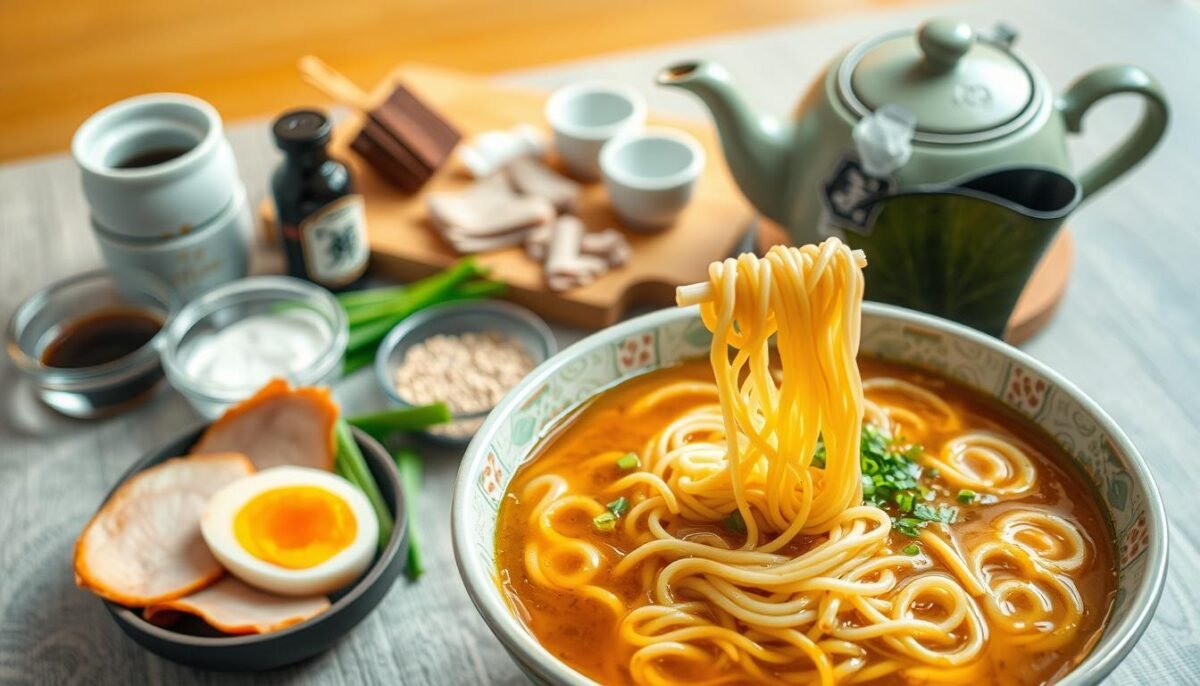
Discover the Heart of Italy: 7 Traditional Dishes You Can Cook at Home
April 25, 2025
The Ultimate Guide to Cooking Like a Greek Grandma
April 26, 2025I still remember the first time I tasted real tonkotsu broth. It wasn’t in a bustling Tokyo alleyway or a fancy restaurant—it was in my tiny apartment, after three failed attempts and a kitchen that smelled like pork bones for days. That moment taught me something: creating soul-warming bowls of comfort isn’t about shortcuts. It’s about embracing the joy of slow, intentional cooking.
My journey began with instant packets during college—quick fixes that left me craving depth. Then came a life-changing trip where I learned the magic behind steaming bowls served in Osaka. The chef told me, “Good broth takes time, but it also takes heart.” That’s when I realized: this isn’t just food. It’s a craft.
Now, I want to share that craft with you. We’ll dive into silky broths simmered for half a day, springy noodles with the perfect chew, and toppings that sing with umami. Yes, it’s a project—but one that turns weeknights into adventures and kitchens into places where memories simmer alongside pots of stock.
Key Takeaways
- Tonkotsu broth requires 12-18 hours of simmering for maximum richness
- Five core elements (broth, noodles, pork, egg, tare) create balance
- Quality ingredients elevate flavor more than complicated techniques
- Patience yields deeper, more complex tastes than quick versions
- Customization makes the dish uniquely yours while staying traditional
Introduction: My Journey into Homemade Ramen
There’s a moment when store-bought broth just stops satisfying—that’s when the real journey begins. My turning point came after a trip where every slurp of street food taught me what my kitchen was missing. I returned home determined to recreate those layered flavors, starting with a simple truth: great meals demand attention to detail, not just convenience.
The Allure of Authentic Japanese Flavors
I’ll never forget the vendor who showed me his stockpot bubbling with chicken bones and kombu. “Good food whispers,” he said, stirring a brew that had simmered since dawn. That’s when I understood: depth comes from time, not shortcuts. My first attempts used quick-boil methods—watery disappointments that proved broth needs hours, not minutes, to develop character.
Why I Decided to Make Ramen at Home
Six-minute eggs became my obsession. Getting that custard-like yolk required precision I’d never applied to cooking. But when I finally nailed it? Pure magic. I realized controlling ingredients—from fresh garlic to artisanal soy sauce—let me craft bowls that felt personal yet traditional. Now my kitchen smells like patience, and every simmering pot tells a story.
Essential Ingredients and Tools for a Perfect Bowl
Building a memorable dish starts with understanding its DNA. I learned this the hard way when my early attempts tasted like separate elements floating in broth rather than a cohesive experience. Every component must work in harmony—like instruments in an orchestra.

Key Components: Broth, Noodles, Pork, Egg, and Tare
Broth forms the soul. My mentor once said, “Water quality matters more than you think—mineral content changes everything.” I switched to filtered spring water and suddenly my tonkotsu base gained velvety richness.
Fresh noodles outshine dried versions with their springy texture. Look for ones with kansui (alkaline mineral water) in the ingredients. For pork, thick-cut belly with marbled fat renders down into melt-in-your-mouth perfection.
Don’t overlook the tare—this seasoned sauce anchors flavors. My secret? A blend of aged soy and bonito flakes simmered for hours. And those eggs? They’re not just toppings. The yolk’s creaminess ties the whole bowl together.
Must-Have Kitchen Equipment
These tools became my allies:
- A heavy-bottomed pot that withstands 18-hour simmers
- Fine-mesh strainer for crystal-clear broth
- Timer with multiple alerts (egg doneness waits for no one)
- Noodle basket for perfect portion control
Your biggest asset? Patience. Great meals can’t be rushed—they need space to develop character.
Authentic Japanese Ramen Recipe: Breaking Down the Five Major Components
Great bowls aren’t built—they’re balanced. Like a symphony conductor, I learned to coordinate five distinct elements until they sing together. Let’s explore what makes each component essential.
Understanding Tonkotsu Broth
My first successful batch transformed pork bones into liquid silk through relentless simmering. 18 hours breaks down collagen into gelatin, creating that signature mouthfeel. Pro tip: Skim foam early for clarity, then let time work its magic.
For pork belly, I swear by sous vide. 36 hours at 165°F renders fat into velvet while keeping meat succulent. Slice it thin—it should nearly dissolve on your tongue when paired with rich broth.
Fresh Noodles: The Springy Foundation
Alkaline kansui water gives noodles their golden hue and bounce. No kansui? Bake baking soda at 250°F for an hour to create a substitute. Cook them al dente—they’ll soften slightly in hot broth.
The tare (seasoning base) matters more than you think. My blend uses three soy products: dark soy sauce for depth, white soy for brightness, and miso for umami. A garlic clove simmered in the mix adds aromatic complexity without overpowering.
Finish with chili oil made from toasted sesame and crushed flakes. Its heat shouldn’t burn—it should whisper, “Try another bite.”
Crafting the Heart: Preparing a Rich and Flavorful Broth
The alchemy of transforming bones into liquid gold begins with one non-negotiable: time. My third attempt at tonkotsu taught me this truth—when I rushed the simmer, the broth stayed thin and lacked that luxurious mouthfeel. Now I treat my pot like a trusted friend, letting it work its magic undisturbed for half a day or more.

Simmering for 12-18 Hours: The Slow Cook Process
Here’s what happens during those long hours: collagen melts into gelatin, marrow infuses the liquid, and flavors concentrate into something extraordinary. I use a 12-quart stock pot filled with 8 cups of cold water to start. Pro tip: Add cloves garlic and ginger during the last 4 hours—they’ll burn if introduced too early.
Struggling with weak heat? My apartment stove once couldn’t maintain a rolling boil. Solution: Wrap the pot in foil to retain heat. Got a slow cooker? Set it on high, but expect lighter color in exchange for convenience.
Tips for Freezing and Storing Your Broth
Cooling matters as much as cooking. I pour hot stock into mason jars, leaving inch gaps for expansion. Once room-temp, they go flat in the freezer. For quick use, freeze in 2-cup portions—perfect for single servings.
Need longer storage? Pressure-can your chicken broth base. I’ve kept jars for 6 months without flavor loss. Just remember: Fat separates when frozen. A quick whisk after thawing restores that velvety texture.
Mastering Noodle Techniques: From Fresh to Dried
Noodles transformed from afterthought to centerpiece in my kitchen when I discovered their texture makes or breaks the dish. Fresh varieties require precise instructions—boil 6 cups water with a pinch of salt, then stir constantly for 90 seconds. Dried versions? They need gentler treatment—simmer 3 minutes while testing bite.

My early prep mistakes taught me valuable lessons. Store-bought noodles once turned mushy because I ignored package directions. Now I time everything: 1 minute 45 seconds for fresh, 3 minutes 10 seconds for dried. Always shock in ice water afterward—it stops cooking and preserves springiness.
Need alkaline noodles without specialty shops? Combine 2 cups water with ½ teaspoon baked baking soda. This DIY base mimics kansui’s effect, giving homemade strands that signature chew. For extra bounce, knead dough longer than you think necessary—8 minutes minimum.
Temperature matters as much as timing. I keep my broth at 190°F while cooking noodles—too hot, and they overcook; too cool, and they turn gummy. When assembling bowls, layer base flavors first (tare, garlic oil), then noodles, then piping-hot stock. This order protects texture while blending flavors.
Pro tip: Rinse dried noodles under cold water after cooking. It removes excess starch that clouds broth and alters mouthfeel. With fresh varieties? Skip rinsing—their natural starch helps thicken the base beautifully.
Elevating Flavor with Pork and Tare Mastery
Perfecting chashu pork became my obsession after discovering how texture transforms taste. My sous vide method—145°F for 24 hours—creates silkier meat than traditional braising. For those without equipment, try oven-braising at 275°F with kombu-wrapped pork: the slow heat still delivers fork-tender results.

Tare sauces anchor every bowl. Soy-bacon versions offer smoky depth (simmer smoked jowl with mirin), while miso blends bring earthy complexity. Balance them like a painter mixes colors—start with 1:1 ratios, then adjust. A chef friend once whispered, “Your tare should make you pause mid-sip.”
Toasting sesame seeds until golden, then blending with roasted garlic oil, adds nutty richness. Watch the pan closely—they burn faster than you’d think. Drizzle this mixture over noodles just before serving to preserve its aromatic punch.
Chili integration requires finesse. I steep dried flakes in warm oil (180°F) for 20 minutes, straining before the heat turns bitter. This controlled infusion adds warmth without overpowering other elements. Remember: flavor layers build gradually—like a good story.
When these components unite, magic happens. Velvety pork melts into umami-rich tare, while chili’s whisper and sesame’s crunch create texture contrasts that keep each bite exciting. It’s not just cooking—it’s edible alchemy.
Perfecting Toppings: Eggs, Mushrooms, and More
Toppings transformed my bowls from good to unforgettable. Let’s start with the showstopper: eggs with custard-like yolks. Bring water to a rolling boil, then gently lower room-temp eggs. At 6½ minutes, plunge them into ice—the whites firm up while yolks stay molten gold. Peel carefully; marinate in soy-mirin mix for 48 hours. That’s when magic happens.
Shiitake mushrooms need contrasting textures. Slice them thick, sauté in sesame oil until edges crisp. Add a splash of cooking sake—it deepens their earthiness without making them soggy. Toss with minced garlic at the end for aromatic punch.
Balance matters most. A rich soup base needs bright accents. Thinly sliced green onions work double duty: whites simmered in broth add depth, while greens garnish with fresh bite. Scallion oil? Blend charred stalks with neutral oil—drizzle it over noodles for smoky complexity.
Want to play while staying classic? Try these ideas:
- Quick-pickled radishes (30 minutes in rice vinegar)
- Crispy garlic chips fried in leftover pork fat
- Nori strips folded into origami shapes
Every element should enhance, not overpower. My rule? Taste each topping with broth before assembling. If it makes you smile, it belongs in the bowl. That’s how traditions evolve—one creative twist at a time.
Creative Variations and Ingredient Substitutions
One afternoon, a missing pork belly forced me to improvise—and revealed how flexible this dish truly is. Swapping proteins became my new obsession. Chicken thighs braised in ginger beer? Surprisingly divine. Smoked tofu? Adds earthy depth to lighter broths.
Even instant ramen gets a glow-up here. Try simmering store-bought noodles in homemade stock instead of water. A teaspoon of miso paste stirred into the seasoning packet creates layered complexity. My favorite hack? Top with quick-pickled veggies from that exploring Japanese cuisine at home project you tried last month.
| Element | Homemade Upgrade | Instant Hack |
|---|---|---|
| Broth Base | 48-hour chicken bone broth | Add roasted garlic oil |
| Protein | Sous vide duck breast | Leftover rotisserie chicken |
| Seasoning | White vs red miso blend | Toasted sesame seeds |
| Toppings | Chili-crisp mushrooms | Fried egg & scallions |
Miso quantity changes everything. Double the amount for bold umami punches, or use half with extra kombu for subtle salinity. Last week, I mixed yellow and white varieties—the result tasted like a savory symphony.
Soup texture matters too. Simmer your base until it coats the spoon like velvet, or keep it brothy for lighter meals. My favorite ramen balances both: thick richness underneath, clearer flavors on top. Remember—tradition guides, but creativity fuels. What twist will you invent tonight?
Conclusion
When I finally lifted that first perfect bowl to my lips, every hour spent simmering felt justified. Through trial and error, I discovered that soulful meals aren’t about perfection—they’re about embracing the process. The journey taught me to see humble ingredients anew: eggs became golden pools of richness, toasted sesame added nutty crescendos, and even broth scraps transformed into freezer treasures.
Yes, crafting these bowls demands patience. But the reward? A harmony of textures and flavors that you orchestrate. Start with the basics—master the tare, nail the egg timing, then tweak ratios to suit your taste. That’s the beauty: recipes are guides, not rules.
To anyone hesitating—dive in. Your kitchen might smell like pork bones for days, but the first sip of deeply layered broth will erase all doubts. Share your creations, swap stories, and remember: great food connects us. Now, who’s ready to slurp?
FAQ
Can I make the broth faster than 12 hours?
I’ve found using a pressure cooker cuts simmering time to 3-4 hours while still achieving a rich, creamy texture. Just strain it well after cooking!
What’s a good substitute for pork belly?
Chicken thighs or smoked tofu work beautifully. I’ve even used roasted mushrooms for a veggie-friendly twist without losing that savory depth.
How do I store leftover broth?
Freeze it in ice cube trays or portioned containers. When I’m ready to use it, I thaw it overnight and reheat with a splash of water to adjust consistency.
Are fresh noodles really better than dried?
Fresh ones have a springy bite I love, but quality dried noodles (like Sun Noodle brand) work in a pinch. Just avoid instant varieties with seasoning packets.
Can I make this vegan?
Absolutely! Swap tonkotsu for a kombu-mushroom broth and use miso or soy-based tare. Top with marinated tofu or eggplant—it’s still packed with umami.
What toppings are essential?
Soft-boiled eggs and scallions are my non-negotiables. For extra flair, try quick-pickled veggies, nori strips, or a drizzle of chili sesame oil.



